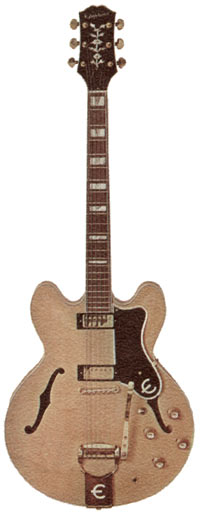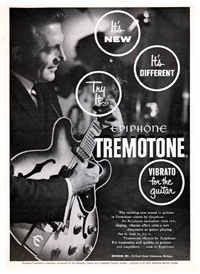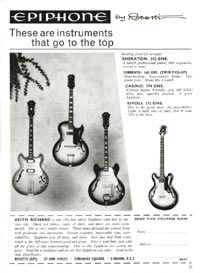
 Epiphone Sheraton E212TNV in Natural finish with vibrola
Epiphone Sheraton E212TNV in Natural finish with vibrola
The Epiphone Sheraton, or Epiphone E212T was essentially an ornate version of the Epiphone Riviera. The 1960s Sheraton was Epiphone's second most expensive model (after the Emperor). As a highly decorated double cutaway, it naturally drew comparisons to Gibson's ES-355 (the non varitone version) - it was around the same price - in 1963, the E212TV (with vibrola) was listed in the US (zone 1) at $595 - compared to $635 for a similarly equipped ES-355TD. The Sheraton was produced side by side with other Epiphone and Gibson thinline models at the famous Kalamazoo plant in Michigan. It was not a continuation of any pre-Gibson Epiphone model, however, but it was initially fitted with left-over Epiphone New York pickups, changing to mini-humbuckers early in the decade.
Like the Gibson 335/345/355 Electric Spanish thinlines, the Sheraton was semi-hollow with a maple top, back and sides, and maple center block to reduce feedback. The set (glued in) mahogany neck had a bound rosewood fretboard with very ornate inlays - these had a central abalone triangle within a rectangular mother-of-pearl block. The body was bound front and back, the front having seven ply white and black (w/b/w/b/w/b/w) binding.
The Sheraton was not produced in especially large numbers (see shipping stats below), with just 617 instruments shipped between 1961 and 1969; 1967 being the peak year. The model was available in the standard Shaded finish (70% of guitars shipped were in this finish), Natural and Cherry. According to shipping stats, Cherry was available from 1967, though from 1962 Cherry was listed in catalogues, and price lists. It was given the same model code as the Shaded finish, and it may just be that the shipping data lumped these finishes together prior to 1967.
The Sheraton was relaunched in the early 1980s, and built in Japan. Although in a different league to the American-built instruments of the 1960s, it was still a very nice guitar, stylistically much the same as the original, but with a maple (rather than mahogany) neck, and a maple/mahogany combination central block within the body "for additional sustain and high frequency response". Finishes were a darker Antique Sunburst, or Wine Red.
Production continues to this day, with guitars built in Korea and China by several different manufacturers. An Epiphone elitist, and John Lee Hooker signature model also exist.
The shipping figures are split by finish and with/without vibrola E212T = Shaded finish; E212TN = Natural finish; E212TCh. = Cherry finish. V = with vibrola
| 1959 | 1960 | 1961 | 1962 | 1963 | 1964 | 1965 | 1966 | 1967 | 1968 | 1969 | total | |
| E212T | 43 | 17 | 24 | 9 | 10 | 26 | 26 | 47 | 40 | 41 | 19 | 302 |
| E212TV | 21 | 18 | 16 | 36 | 35 | 27 | 22 | 14 | 7 | 196 | ||
| E212TN | 3 | 9 | 10 | 1 | 7 | 8 | 13 | 7 | 6 | 2 | 5 | 71 |
| E212TNV | 2 | 6 | 3 | 10 | 17 | 4 | 3 | 3 | 48 | |||
| E212TV Ch. | 19 | 19 | ||||||||||
| E212T Ch. | 33 | 7 | 13 | 53 | ||||||||
| total | 46 | 26 | 57 | 34 | 36 | 80 | 91 | 85 | 123 | 67 | 44 | 689 |
As is always the case with Gibson / Epiphone shipping statistics, some care must be made interpreting them. In 1959 and 1960, for example, the Sheraton was only offered with a Tremotone vibrola - however the model designation was E212T / E212TN - the non-vibrola model designation from 1961 onwards. Furthermore, the Cherry-finished models were not split in the statistics prior to 1967, so 1962-66 E212T and E212TV numbers most likely include an unspecified number of guitars with Cherry finish. So on the surface it would seem just 263 out of 689 (38%) of Sheratons were fitted with the Tremotone - if the 1959 and 1960 examples all (and this might not be the case!) shipped with the Tremotone, the number rises to 335 (49%).
Electric guitar advertisements originally published from 1962 onwards. Click on the images for larger copies. Check out other vintage Epiphone advertisements

Epiphone Sheraton - Epiphone Tremotone. Vibrato for the guitar. (1962)
"It's new, it's different, try it..."
Early Epiphone advertisement for the Epiphone Tremotone vibrato; initially fitted as standard to the Epiphone Sheraton, Casino and Crestwood Custom. The...
[more]

Rosetti Sheraton - These are instruments that go to the top (1964)
British advertisement for Epiphone guitars - placed in UK publication Beat Instrumental by distributor Rosetti in November 1964. The guitars featured represent some of the hollow and semi-hollow gu...
[more]
$8000
$25900
$700
£1700
£2100
£1027
£1129
£2047
£2200
$600